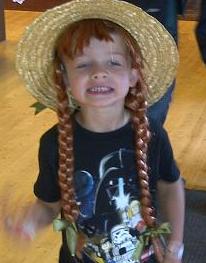Before I had my son, I’d never seen a Star Wars movie. I called Darth Vader “Dark Vader” and I thought a Wookie was something you gave to someone you didn’t like.

Five years later, this is what a typical Sunday looks like for me. Note that we watched two Star Wars movies before this battle. Please also note that I asked for the blue lightsaber but was denied. Actually, that is not strictly true. I asked for the blue one, was allowed to have the green one but then that was taken away and I was given the red one (**cough, Dark Side**), at which point both of my children attacked me with two lightsabers and a Curious George bat. I digress…
The point of this post is not to tell you why I have a strange collection of bruises on my forearms, nor is it to tell you why my cat had to hide behind the couch for an hour. No, my dear Padwans, the point is to tell you something I have learned about Darth Vader, or more specifically, about Anakin Skywalker.
There’s no better antagonist’s character arc than the one you see for Anakin in the 3rd movie (Revenge of the Sith).
Now, I know that Anakin is technically a tragic hero and does not become an antagonist until the next movie. Either way, I think the lessons from the arc apply to both. And here they are:
1) We have a reason to love Anakin at the beginning of this movie. The prophecy says he will put the universe in order and he’s a talented Jedi who is fighting for the good guys. Plus, we love Obi Wan and Padmé and they love him so he must be good, right?
LESSON HERE: A great antagonist needs to be likeable in some way, especially in the beginning.
2) Anakin’s motivations are good. He wants nothing more than to make sure Padmé survives.
LESSON HERE: On some level, we need to be able to understand if not agree with the antagonist’s motivation.
3) But he has flaws. Anakin has a hunger for success. He’s impatient and has a hard time trusting others. Both Obi Wan and the Council ask him to be patient and trust them, but rather than do so, he lets the Emperor convince him that the only way to save Padmé is to use the dark side. Because Anakin WANTS to be the hero and doesn’t want to wait, he’s easily convinced to take this path because his intentions are good, right?
LESSON HERE: Usually around the midpoint of your novel, an opportunity presents itself which plays on the antagonist’s previously established weaknesses. At this point, the reader should still be able to understand why the antagonist is thinking what he’s thinking (although this is often when they start to think, Uh-oh…)
4) Then comes the choice. With every great fall in an arc, you will see a choice and this is one the clearest I’ve ever seen. The Emperor (dark side) and Mace Windu (good side) are trying to kill each other and Anakin can only help one of them. The Emperor says, YOU MUST CHOOSE ANAKIN. Anakin only sees what he believes is right and so he chooses. And he’s wrong.
LESSON HERE: There is usually a choice before the antagonist falls. Make it one that’s really difficult for him and you will create not just tension, but an antagonist that is truly sympathetic. If you are really talented, you might even create an antagonist that readers secretly root for.
5) Then comes the consequences of the flaw. Anakin cannot take back his choice and so he goes forward with the dark side. There’s still part of him that wants to be with Padmé and that still wants to believe he chose right. We haven’t totally given up hope yet because there’s still part of Anakin that wants to fix this even though we know he can’t.
LESSON HERE: The longer the antagonist struggles between good and evil, the longer the reader will stay entranced. If he becomes completely bad with the turn of a page, we will question whether he was ever good which means we will question YOU the narrator.
6) Time for the nail in the coffin. Obi Wan and Padmé still want to help Anakin but because Anakin doesn’t trust people, he’s easily led to believe that they have turned on him. Insert fierce battle and hot lava. Then the Emperor tells Anakin that he killed Padmé and Anakin has no more reason to be good.
LESSON HERE: If you want to make your main character fall far and fall hard, take away his motivation (#2). And if you want everyone to think you’re brilliant, make him responsible for his own demise.












